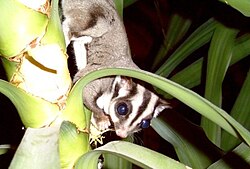Wrist-winged glider
| Petaurus | |
|---|---|
 |
|
| Sugar glider | |
| Scientific classification | |
| Kingdom: | Animalia |
| Phylum: | Chordata |
| Class: | Mammalia |
| Infraclass: | Marsupialia |
| Order: | Diprotodontia |
| Family: | Petauridae |
| Genus: |
Petaurus Shaw, 1791 |
| Type species | |
|
Petaurus australis Shaw, 1791 |
|
| Species | |
The genus Petaurus contains flying phalangers or wrist-winged gliders, a group of arboreal marsupials. There are six species, sugar glider, squirrel glider, mahogany glider, northern glider, yellow-bellied glider and Biak glider, and are native to Australia or New Guinea.
Flying phalangers are typically nocturnal, most being small (sometimes around 400 mm, counting the tail), and have folds of loose skin (patagia) running from the wrists to the ankles. They use the patagia to glide from tree to tree by jumping and holding out their limbs spread-eagle. They are able to glide for distances over 140 metres. Beside the distinctive skin folds, flying phalangers also have large, forward-facing eyes, short (though pointed) faces, and long flat tails which are used as rudders while gliding.
All are omnivores, and eat tree sap, gum, nectar, pollen, and insects, along with manna and honeydew. Most flying phalangers appear to be solitary, though the yellow-bellied glider and sugar glider are both known to live in groups.
While Biak and sugar gliders are relatively common, most of the other species are rare. Mahogany gliders are endangered, and so uncommon that they weren't seen for more than a hundred years after their original discovery in 1883. Nearly a month after they were rediscovered in 1989, their habitat was cleared for plantations, and another population wasn't found until 1991.
...
Wikipedia
